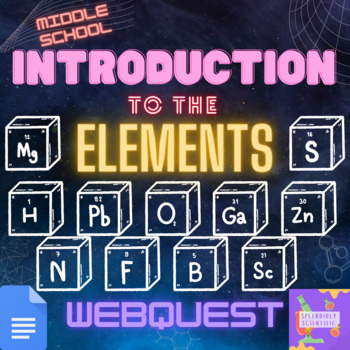Elements Intro - Webquest - Middle School - Sub work - MS-PS-1-1 MS-PS-1-4
- Google Drive™ folder
- Internet Activities
- Webquests

Also included in
- These activities align perfectly with MS-PS1-1! They are all digital products (Google sheets, Google sheets), however they can all be printed out as well. Some of them do require access to the internet to complete.1. "Introduction to the Elements" This webquest will give them an overview of some ofPrice $9.00Original Price $11.00Save $2.00
Description
Teaching about elements and compounds? Start here! It can be a bit overwhelming for students at first to look at the Periodic Table of Elements. This webquest will give them an overview of some of the more common elements.
In part 1, students will use one website to find one use for each element (or where it is commonly found). In part 2, students will use another website to identify an element based on its photo.
This is a good activity for independent work, and can be given as classwork, homework, or work to leave for a substitute if you are out (if you share it ahead of time).
The document is designed so that students can write their answers directly in the Google Doc, however it can also be printed so students can write their answers on paper (however they will still need access to the websites linked in the activity).
Check out my other resources here!
Instructions for assigning to your students:
Option 1: Share digitally, so that students can write directly in the document:
1. To share with your students, you first need to change the share settings of your file. To do this, click the "share" button at the top of the document
2. Change the share settings to “Anyone on the internet with this link can view”, then select “copy link”.
3. When sharing the link with students (whether through email, or a platform like Schoology), you need to edit the link so when they open it up it will force them to make a copy of the document in their Google Drive. To do this, when you paste the link to assign to your students, you need to delete the word edit and everything that comes after it, and replace it with the word copy.
4. Share that new link with your students so that it will make a copy of the document that they can edit. Doing this will not affect your original file.
Option 2: Share paper version:
- Print out document, and give one to each student.






